In the past, I've sometimes travelled to Leeds via Birmingham and Derby but I'd decided to travel via Manchester to Leeds, allowing me to stop off at Huddersfield for photographs. In fact, the National Rail Journey Planner recommended the route via Manchester in any case.
The Outward Journey
I started from Wolverhampton at 06:49, catching the Arriva Cross Country 'Voyager' which runs via the former LNWR route to Norton Bridge (north of Stafford) then over the former North Stafford Railway route via Stone, Stoke-on-Trent and Macclesfield, rejoining the LNWR Crewe to Manchester line at Cheadle Hulme (just south of Stockport). It irks me that the diesel-electric 'Voyagers' run 'under the wires' to Manchester because their route south of Birmingham to Bristol and the West Country is not electrified.
We arrived at Manchester Piccadilly (formerly Manchester London Road) on time at 07:59, giving me adequate time to cross the station to through platform 13 for the 08:10 First TransPennine Express service for Leeds and beyond, operated by a 3-coach Class 185 'Desiro' multiple unit built by Siemens. The train was already well-loaded and with a large number of reserved seats but at least I found a seat (an improvement on previous trips where I've often had to remain standing).
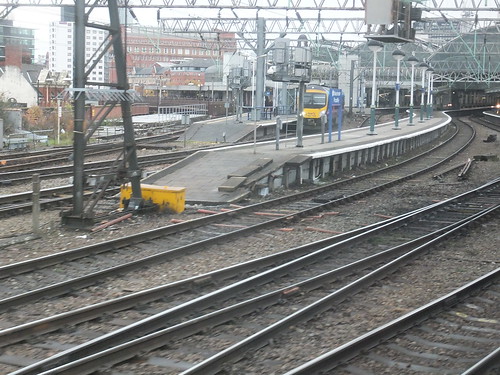 A First TransPennine Express in platform 13 at Manchester Piccadilly in 2013.
A First TransPennine Express in platform 13 at Manchester Piccadilly in 2013.
We picked up a lot more passengers at Stalybridge and then continued on the hilly route into Yorkshire, taking the double track Stalybridge Old Tunnel through Mossley and Greenfield to Diggle. This was an important passenger and freight route for the Lancashire and Yorkshire Railway and from Stalybridge there had been a separate double-track line through Micklehurst, now abandoned, which rejoined the Mossley line at Diggle from where the line continued as four-track to Thornhill. Today, the route is double track although the evidence of the abandoned lines can be seen. Beyond Diggle, we passed through through the 3-mile long double-track Standedge Tunnel. There remain the two abandoned single line tunnels which carried the slow lines before the competition from road transport took away most of the freight traffic. From Manchester, the line climbs continuously to Standedge Tunnel which is level and is the summit of the line. Emerging from the tunnel, it's then downhill right through Huddersfield to Thornhill. There's some information on the route from Stalybridge to Heaton Lodge on the 'Lost Railways West Yorkshire' site here.
Huddersfield Interlude
I alighted at Huddersfield just before 08:45 because I wanted to take some pictures of the remarkable station buildings, which incorporates a range of massive stone buildings with the appearance of a major country seat in Classical style. The famous Doric Arch at Euston station is long gone (in an earlier post on London's Terminal Stations I refer to its demolition as "an act of gross vandalism which will never be forgiven") but Huddersfield retains its magnificent station.
There's a description of the Grade 1 buildings at Huddersfield in "Architect Speak" on the British Listed Buildings Site here. The two-storey central building has six massive columns at the front flanked by colonnades terminated in single-storey lodges on either side.
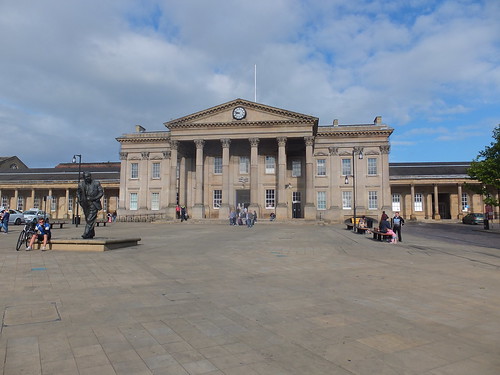 Huddersfield Station.
Huddersfield Station.
The lodge on the left is now the railway-themed 'Head of Steam' public house. The stone pediment carries the carved arms of the Lancashire and Yorkshire Railway, painted in the correct colours.
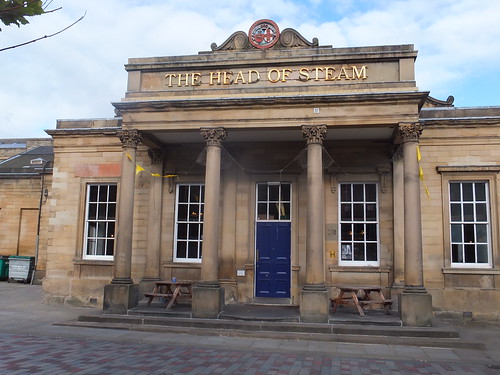 The 'Head of Steam'.
The 'Head of Steam'.
The lodge on the right is currently receiving attention from builders. This lodge is also now a public house called the 'King's Head'. The stone pediment carries the carved and coloured arms of the Huddersfield & Manchester Railway & Canal Company, in need of some restoration.
 The arms of the Huddersfield & Manchester Railway & Canal Company above the 'King's Head'.
The arms of the Huddersfield & Manchester Railway & Canal Company above the 'King's Head'.
Just across the adjacent car park there's a somewhat more utilitarian building carrying a water tank, which has been brought into community use by the Association of Community Rail Partnerships (ACoRP). There's a detailed account of the project to convert the Grade 1 listed Huddersfield Water Tower here.
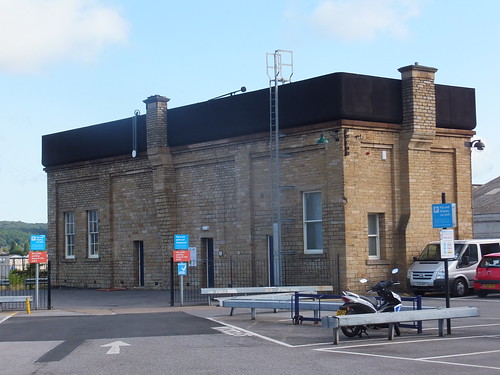 Huddersfield Water Tower
Huddersfield Water Tower
Huddersfield station also has a large brick goods warehouse incorporating a wagon hoist, apparently disused. There's a collection of pictures here. The building has carried a PDR CONSTRUCTION sign for some years. A very brief entry on their website posted on 12th January 2013 by T. Weber refers rather enigmatically to "£15M Private Investment to Transform Warehouse Into Commercial Units In Huddersfield" so I suppose they're waiting for somebody to offer the finance.
 Huddersfield Goods Warehouse.
Huddersfield Goods Warehouse.
The Journey Resumed
Because of time constraints, I couldn't see much of the town on this trip. I boarded a heavily-loaded Leeds train which lost no time heading for Heaton Lodge Junction where we merged with the Calder Valley Line from Preston and Blackburn. Through Mirfield, there's still a 'third line' designated Up Slow. Mirfield was the site of the unique British Speed Signalling installation described on 'The Signal Box' site here. This was put in by the Chief Signal & Telegraph Engineer of the L.M.S. A. F. Bound in 1932 and lasted until 1970. At Thornhill Junction, we took the Dewsbury line and started climbing again to Morley Tunnel (nearly 2 miles long), emerging on a downhill section which would last the final four miles to Leeds.
We ducked under the electrified line from Doncaster to approach Whitehall Road Junction where there are six running roads. From the north, A and B are the Harrogate lines, C and D are the Doncaster/Shipley lines and E (our line) and F are the Huddersfield lines. Although the six roads normally operate as three sets of double track, they are all bi-directional when required. Control is from York Integrated Electronic Control Centre (IECC). We entered the station on the Through Road and, halfway through the station, took the crossover to stop in platform 12c. The through platforms numbered 7 to 16 (there's also now a bay platform 17) formed Leeds New Station which was shared by the LNWR and the North Eastern Railway.
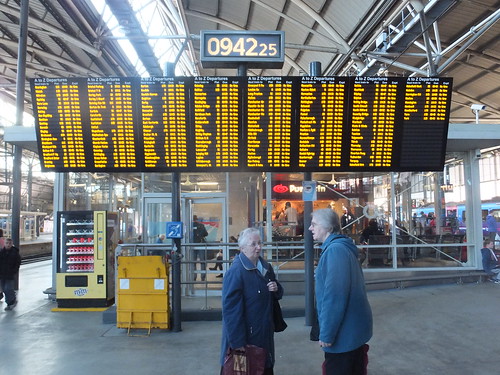 Leeds: A fairly daunting Passenger Information Display on platform 12/15.
Leeds: A fairly daunting Passenger Information Display on platform 12/15.
I identified the next Shipley departure and scuttled across the footbridge to reach the terminal platforms numbered 1 to 6 (which originally formed the Midland Railway's separate Leeds Wellington Street Station. Beyond the Midland station was a further terminus, Leeds Central, which was originally joint LNWR, Lancashire & Yorkshire Railway, Great Northern Railway and North Eastern Railway. Once Leeds New Station opened, the importance of Leeds Central declined and it was finally closed in 1967). I'd been directed to a 2-car Class 158 for Carlisle which was about due to leave but the platform was still crowded with waiting passengers and the lady Guard who was unable to open the doors until the Driver climbed into the cab and started the engines. We were pretty full leaving Leeds but I secured as seat and we soon set off on the Down Harrogate, crossing to the Down Shipley at Armley Junction. It didn't take long to cover the 12 miles to Shipley, where the train stopped briefly in platform 2.
 Shipley platform 2, showing the Class 158 setting off for the Settle - Carlisle line.
Shipley platform 2, showing the Class 158 setting off for the Settle - Carlisle line.
Being a station on a triangle of lines, it's easy to be disoriented. I wanted the Station Road exit, so I asked a member of platform staff. He admitted he'd only just moved to Shipley and had no idea. He suggested I check with another member of platform staff who seemed equally foxed. "I think the exit is through a subway" I added, to which the response was a shaking of the head. I lifted my eyes and immediately spotted a sign saying "EXIT - SUBWAY" not ten yards from where we were both standing.
So I was able to walk to the 'Lionsmeet' event and spend a pleasant day with old friends and new friends. One of the club members was concerned at the thought of me walking back to the station and insisted on taking me by car. The next service to Leeds was from Bradford Forster Square (a little under 3 miles away) and I had a few minutes to look around. The original stone station buildings were attractive, later additions in places were not so good and the modern footbridge with lifts was, as usual, out of sympathy with the remainder. The Booking Hall, with its curved glazed screen, was quite appealing, despite the modern fixtures and fittings.
 Shipley Station: the Booking Hall.
Shipley Station: the Booking Hall.
The Return Journey
My train to Leeds arrived at Shipley on time - an almost empty Class 333. It was quiet, comfortable and fast.
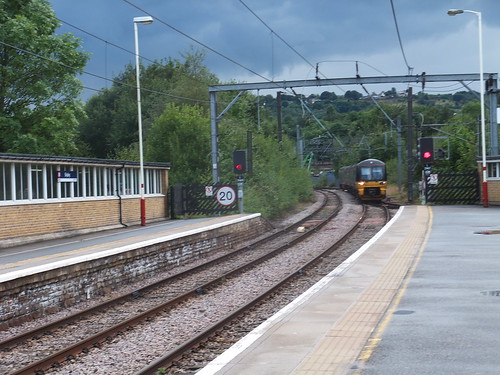 The Class 333 approaching Shipley platform 3 which returned me to Leeds.
The Class 333 approaching Shipley platform 3 which returned me to Leeds.
I finally managed a picture from the train of the two towers adjacent to the station, without the usual "knitting" of the overhead catenary. Only later did I discover they are the Verona Tower of 1864 (actually the boiler house chimney) and the Giotto Tower of 1899 (actually a dust extraction chimney), the remaining parts of the Tower Works of local industrialists the Harding Family. There's an interesting article on the 'Architecture Today' site here. The inspiration for the Leeds Verona Tower is the (much taller) Torre dei Lamberti in Verona, briefly described in Wikipedia here and the British Listed Buildings entry for this Grade II* structure is here. The inspiration for the Giotto Tower is the Giotto Campanile in Florence and is described in Wikipedia here and the British Listed Buildings entry for this Grade II* structure is here.
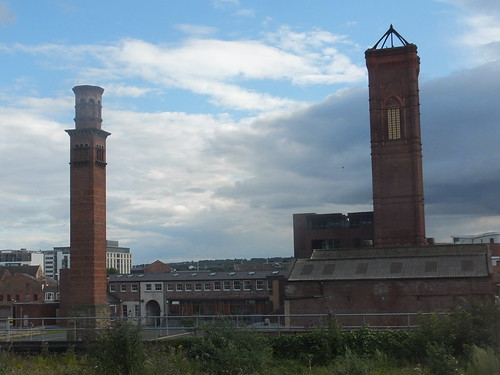 L: The Verona Tower, R: The Giotto Tower.
L: The Verona Tower, R: The Giotto Tower.
Back at Leeds, I made my way to the through platforms for the First TransPennine Express to Manchester Piccadilly. We set off with plenty of spare seats but, by the time we made our last pick-ups at Stalybridge, we were back to people standing. At Piccadilly, I caught the next Arriva Cross Country to the south-west via Wolverhampton.
My pictures
West Midland Railways.
Stoke Area Rail.
Manchester Area Rail.
Huddersfield Station.
Yorkshire's Railways.
Shipley Station.
